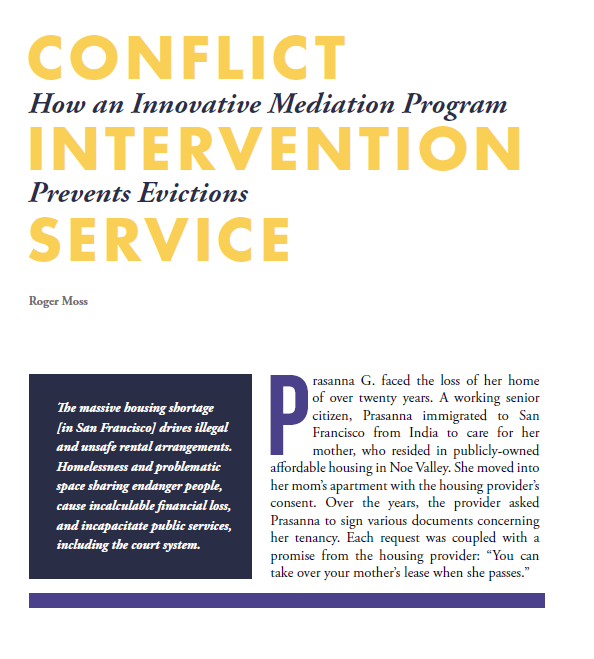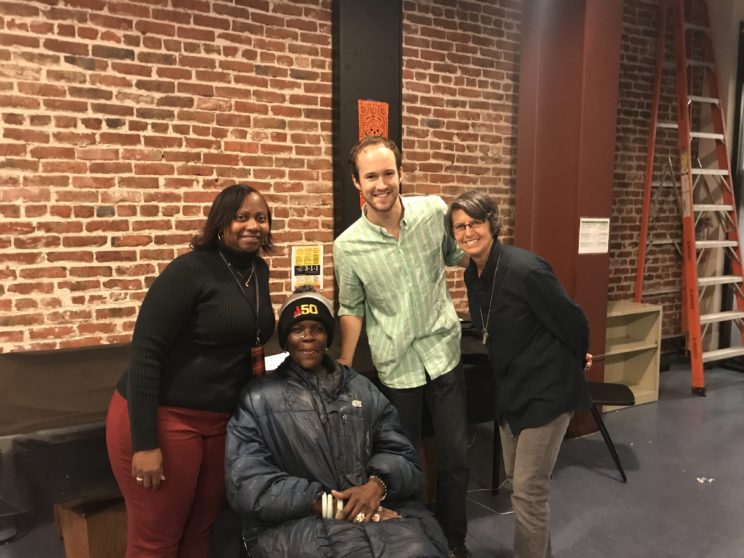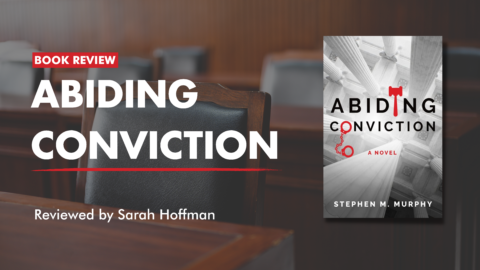
Prasanna G. faced the loss of her home of over twenty years. A working senior citizen, Prasanna immigrated to San Francisco from India to care for her mother, who resided in publicly-owned affordable housing in Noe Valley. She moved into her mom’s apartment with the housing provider’s consent. Over the years, the provider asked Prasanna to sign various documents concerning her tenancy. Each request was coupled with a promise from the housing provider: “You can take over your mother’s lease when she passes.”
Yet in June 2017, still grieving the loss of her mother who had passed that spring, Prasanna found herself holding a legal notice from the landlord to move out immediately or face eviction. To make matters worse, Prasanna could not get legal representation because of a 2005 caretaker agreement she had signed that voided her right to succeed her mother as the apartment’s leaseholder. She “had no case,” according to respected tenant attorneys with three nonprofit advocacy groups.
There may have been no legal case, but fortunately for Prasanna, she called BASF’s Conflict Intervention Service, which found an alternative resolution through mediation. Today, she remains in her home of over two decades with a long-term lease.
The homelessness crisis in San Francisco needs no introduction. At least 7,500 San Franciscans live on the streets. Prasanna could have been one more added to the numbers. The massive housing shortage also drives illegal and unsafe rental arrangements. Homelessness and problematic space-sharing endanger people, cause incalculable financial loss, and incapacitate public services, including the court system.
These urgent conditions challenge communities throughout the Bay Area and the nation.
A critical element of the City of San Francisco’s war on homelessness is to prevent it whenever possible. Eviction prevention programs focused on tenant advocacy for vulnerable residents are a core component of these efforts. And still, the magnitude of the crisis calls for lateral thinking and bold initiatives. In 2016, the city tapped the Bar Association of San Francisco (BASF) to develop a housing mediation pilot program with these attributes, which led to the creation of the Conflict Intervention Service (CIS).
Mediation, But With a Twist
At its core, CIS is a mediation program. Innovative practices and solutions-driven messaging distinguish CIS from traditional mediation in the following ways:
Project Design
The CIS program is grounded in a deep understanding of both tenant advocacy and housing management. It offers facilitation, mediation, restorative justice, communications coaching, skilled negotiation, and social services support to maximize compassionate, practical solutions to housing conflict. CIS delivers these services through an ombudsperson, mediators, and social services support.
Rapid Response
CIS services commence within twenty-four hours of first contact, seven days a week, throughout the year. Responding with urgency to housing conflict is the best prevention against the escalation of conflict that can lead to eviction. CIS methodology prizes fast and early intervention as the elements having the greatest impact to de-escalate conflict.
Interdisciplinary Multicultural CIS Mediator Team
Because mental illness and substance abuse are major drivers of conflict in supportive and affordable housing, CIS approaches its work through the lens of behavioral health. The CIS Mediator roster therefore includes therapists, drug counselors, and social workers, along with attorneys experienced in mental health advocacy. These mediators reflect the city’s diversity, are experienced in housing conflict, and are trained in CIS methodology. CIS also provides for language diversity and supports with interpreters when needed.
CIS offers clients a non-adversarial, collaborative process that is focused on relationships, whether between residents, between residents and housing providers, or within tenant associations or provider staff. CIS models civility, which ripples into the community.
During her search for help, Prasanna contacted a social worker with the Homeless Advocacy Project who referred her to the CIS Helpline. Within minutes, Prasanna was in contact with CIS Mediation Counsel.
Seeing the inherent unfairness in Prasanna’s situation, but sensing that bureaucracy may be to blame, CIS Mediation Counsel contacted several housing provider staff members, eventually finding one who explained a thread of actions that created calamity for Prasanna. A convergence of rule changes, lost files, and poor communication was exacerbated by language barriers. CIS informed provider senior management, who agreed to mediation.
Given the case’s complexity, it was assigned to one of CIS’s attorney mediators. The first session led to an internal procedures review by the provider. The second session produced a settlement that restored the provider’s promises to Prasanna and a lease agreement in her name.
Prasanna’s case demonstrates that CIS mediation can produce results that are not necessarily possible by looking solely through the lens of litigation. Critically, the third-party neutrality of a mediator outside the conflict—who operates in a non-adversarial and confidential setting—helps make it possible to illuminate unfair results that demand correction no matter their legal justification, and for institutional stakeholders to change their minds without fear of the consequences of admitting error.
Prasanna kept her home and the housing provider created new policies and procedures to prevent similar occurrences in the future. Everyone won.
Building a Dialog, Not a Court Case
Housing conflict exists at the intersection of landscape and human interaction. While lease language and the law are important guideposts inside the tenant-landlord relationship, they are not always the most suitable means of seeing through the conflict. The answers to problems are embedded in the landscape itself, and with the participants in conflict. CIS mediators travel to the conflict zone; they walk the neighborhood streets, climb stairs, and engage with residents and provider staff in their homes and offices. Sometimes, the best remedy is to help people establish constructive dialogue about mutual concerns and interests, rather than keep the debate about rights and the law.
Philosophically, CIS seeks to transform one resident, one housing provider, one building at a time with the goal to shift the common assumptions about landlord-tenant relationships and the practice of landlord-tenant law. Instead, CIS regards the landlord-tenant relationship as one that is created, nourished, and managed as a long-term association for the benefit of both resident and property owner.
Illustrating this principle is another case. Janet B. faced eviction for laying hands on a property manager and violating a zero-tolerance policy against violent threats and even minor nonconsensual physical contact. Having experienced countless homeless years on the streets of San Francisco, Janet was terrified of losing her home, where she had resided in safety since 2010.
Janet and the property manager had much in common. Each was an African-American woman who had lived with extreme hardship, suffered trauma, and recovered from the ravages of addiction. Janet was elderly and had grown up in an orphanage in the Caribbean; the manager was young, and a product of tough public housing projects in New York. Each was dynamic, head-strong, and creative in their own way. Perhaps too much alike, they were not going to get along.
The director of support services for the housing location contacted CIS for help and the next day, CIS mediator Simon Boehme met privately with Janet and the director.
For background as to what happened next, it is important to know that Janet found her way out of an impoverished life by becoming a calypso singer. She sang across Europe before tragedy and misfortune landed her alone in San Francisco. The level of trauma Janet has experienced cannot be adequately described. Suffering from extreme post-traumatic stress disorder and mildly bipolar, she finds solace and comfort in her music. In privacy with Simon and the housing director, Janet sang her story, in tales of her own musical composition.
In such extraordinary circumstances, miracles happen. To everyone’s surprise, Simon replied to Janet in song, drawing on his lifelong passion for choir singing and operatic pursuits. Singing with Simon created safety for Janet, deep connection, and trust. In this safe place, it became easy to address the conflict that threatened Janet’s home.
What followed was a simple proposal. Janet and the manager would each agree to turn around if either saw the other one coming. Rules for engagement were made for those times when they both had to share common areas. A two-page handwritten mediation settlement agreement was made, and Janet’s eviction file was recalled from the attorneys.
In the eighteen months since this agreement, there have been minor dustups between Janet and the manager. Under CIS Aftercare, however—a program element that supports parties following mediation—these have been quickly cleaned up by a visit from Simon and a song or two more.
Breaking Through Stereotypes
In another case, Lola K., aged eighty-nine, faced eviction for violating a restraining order involving her service dog Milo, who she routinely let wander unsupervised through the building. Lola had sublet her bedroom in violation of her lease, losing access to a private yard that Milo had used for years. Two lawsuits and a complaint to the City Human Rights Commission were underway when attorneys for both parties contacted CIS.
A CIS mediator was quickly dispatched to visit Lola at home. Rapport came quickly, as did a practical solution. The mediator found a way for Milo to regain access to her yard. Installing a ramp from a living room window would do the trick.
A facilitated conversation followed between Lola and her attorney. In this meeting, Lola named her fear. The new building owner “just wants me out-that’s what they do.” In fact, what came to be revealed was that the owner’s business plan hinged on renovating and renting two empty units, not evicting other tenants. The owner himself was a senior citizen and 3rd generation holder of small properties in the neighborhood, with a reputation as a caring landlord.
Next came a structured mediation between Lola, her landlord, and legal counsel at a neutral CIS location. The landlord immediately agreed to install a ramp for Milo. He explained his plans for the property to Lola. They bonded as seniors who both were the children of immigrants. A written settlement agreement allows Lola to retain her home for as long as she wishes to reside there. All litigation ceased.
This case reveals that common assumptions tenants and landlords make about each other can aggravate conflict. Mediation restores voices to participants that can be lost in litigation. It enables them to see each other as human beings who share mutual concerns and interests.
A Model Worth Replicating
CIS has enjoyed early success, with initial sampling indicating that 95 percent of the time those served by CIS remain housed post-CIS intervention. Ongoing CIS Aftercare and check-ins continue to track results. The qualitative effects of the program have led the city to consult with CIS in support of other initiatives. These include consultations with the city’s Below Market Rent (BMR) asset management team, working with BMR communities, and providing educational and mediation support to residents of the Lower Polk Community Benefit District (CBD).
The CIS team is engaged in nothing less than the preservation of home, hearth, and community. It does so by introducing compassionate, cooperative, interest-based negotiation into an increasingly toxic and stressed world of renters and building owners.
This thinking has attracted attention beyond San Francisco. The first annual gathering of CIS mediators and partners was attended by housing conflict professionals from Seattle and Milwaukee. Local collaborators included representatives from the UC San Francisco Citywide Roving Team, the San Francisco Police Department psychiatric unit, UC Hastings College of the Law, the Human Rights Committee of San Francisco, the San Francisco Apartment Association, and Lower Polk CBD. Following CIS presentations at regional alternative dispute resolution conferences, groups from Vancouver, Canada; Los Angeles; Charleston, S.C.; and Indianapolis have shown an interest in developing similar programs in their communities.
These collaborators agree that the old ways don’t work. They are energized by the prospect of delivering rapid responses to conflict that prevent eviction and greatly increase access to justice.
CIS is now poised to expand its conflict resolution services to others seeking rapid, flexible, and affordable alternatives to the legal process. Soon, CIS services will be available for a reasonable fee to anyone facing housing-related controversy. These offerings will not only provide relief to thousands of tenants and landlords seeking help navigating conflict, they will sustain and expand the ability to provide free services to those who need them.
About the author:
Roger Moss is Mediation Counsel with the Bar Association of San Francisco’s Conflict Intervention Program.




